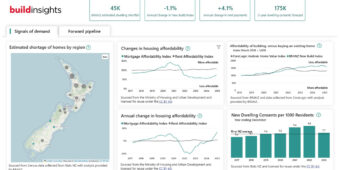New dwelling consents hit six-year high
22 Feb 2014, Industry News

‘Unusually high’ number of new dwellings in December boosts overall figures.
A large increase in new dwellings in Auckland and Christchurch drove 2013 consents to a six-year high, with $12.1bn spent on building work last year.
According to Statistics New Zealand, a total of 21,300 new dwellings were consented in 2013, up 26% from 2012.
The four regions that consented the most new dwellings in 2013 were Auckland, with 6,309 (up 38%); Canterbury, with 5,762 (up 43%); Waikato, with 2,245 (up 24%); and Wellington, with 1,573 (up 27%). However, more new dwelling consents were issued across the board, with nine of the 16 regions consenting new dwellings in 2013 than 2012.
The total value of building work consented last year was up 20%. Of this amount, $7.9bn (just over 65%) was for residential work and $4.2bn (almost 35%) was for non-residential.
The trend for the number of new dwellings eased in the middle of 2013, but has been increasing since then.
December consents push trend to new heights
Across the country, December saw a total of 2,035 new dwellings consented, with 473 apartments, of which 122 were retirement village units.
“December saw a high number of apartments consented in Auckland and a high number of housesconsented in Christchurch,” said industry and labour statistics manager Clara Eatherley.
These were higher-than-usual numbers for a December month. As a result, the seasonally adjusted number of new dwellings, excluding apartments, rose 11%. Including apartments, the number rose 7.6%.
The trend for new dwellings, excluding apartments, is at its highest level since February 2008, and is 78% higher than the most recent low point in March 2011.
“The rend for the number of new dwellings eased in the middle of 2013 but has been increasing since then
The trend for new dwellings, including apartments, is at its highest level since September 2007, and is 98% higher than the series minimum in March 2011. However, it is still 29% below the series maximum in January 2004.
Auckland drives monthly apartment increase
In December 2013, 473 new apartments were consented across four regions.
Most of these were in Auckland, where 397 were consented. December was the second consecutive month witha high number of consented apartments. However, apartment numbers usually fluctuate month to month.
Christchurch drives December’s new dwellings increase
Excluding apartments, 11 of the 16 regions consented more new dwellings in December 2013 than they did in December 2012.
The regions with the greatest movements were Canterbury, which was up 276 to 555 (with 225 of them in Christhurch); Waikato, which increased by 69 to 178; and Auckland, which consented 49 less dwellings down to 307.
Value of building work
In December 2013, the unadjusted value of building work was almost $1.1bn. This consisted of $687m of residential work (down from $798m) and $379m of non-residential work (up from $289m).
The largest contributors to non-residential work, by value and including alterations and additions, were hospitals and nursing homes ($82m, accounting for 22% of all non-residential buildings); offices and administration buildings ($79m, accounting for 21% of all non-residential buildings); and education buildings ($65m, accounting for 17% of all non-residential buildings).
BRANZ endorses foundation repair report
The series of devastating earthquakes that struck Canterbury, beginning on 4 September 2010, provided a unique opportunity for New Zealand engineers to develop new and innovative methods to repair damaged houses.
To help determine the options for damaged homes on TC2 and TC3 land, Housing New Zealand Corporation (HNZC), the MBIE engineering advisory group, BRANZ, Southern Response and other companies engaged geotechnical and structural engineers to conduct trials and identify the different house types required, as well as the different land categories.
The emphasis was on finding economic and viable solutions for either concrete perimeter foundations with timber floors or concrete floor slab foundations.
The final Technical Report on the results of foundation repair trials conducted following the Canterbury Earthquakes was published mid-February and explains the process, methods and results trialled at 19 different HNZC-owned houses in Christchurch. It has been peer reviewed by BRANZ, which gave the technical endorsement required for it to be used as part of MBIE’s building and construction guidelines.
Housing Minister Dr Nick Smith is confident the new resource will help lift the pace of Christchurch’s housing recovery.
“The problem of what to do with the tens of thousands of homes with damaged foundations has been difficult, expensive and hugely frustrating for homeowners.
This technical report is a major step forward in determining what can be fixed, at what cost and with what method,” said Dr Smith, who has a PhD in geotechnical engineering.
If the information does speed up the rebuild process, it will likely be welcomed by frustrated Cantabrians tired of waiting for their homes to be repaired. In mid-January, reports of angry homeowners holding earthquake repair contractors hostage and threatening them with knives reiterated the importance of increasing the pace of the recovery process.
Make sure your knowledge stacks up
The Brick and Blocklayers Federation of New Zealand (BBFNZ) is running its third national roadshow of training for those in the masonry trades. The Federation invites all licensed brick and blocklayers to attend the skills maintenance seminars, which are already under way.
“With its emphasis on LBP skills maintenance, these sessions are a valuable part of keeping building practitioners up to speed,” says Brick and Blocklayers Federation of New Zealand chair Rick Mead.
Highlights for this year’s session include a keynote safety management presentation from Site Safe, with a particular emphasis on getting to grips with new legislation.
There will also be a Q&A session with local senior building officials on issues specific to brick and blocklayers, as well as technical updates from Firth, Dricon, Rothbury Insurance Brokers, BCITO and Bowers Bros Concrete.Members of the BBFNZ branch where the seminars are being held can attend the seminars at no cost.
For non-members, the charge will be $120 per person. Please RSVP to 021 845 825 or admin@brickandblocklayersfederation.co.nz to attend the session closest to you.
Register to earn LBP Points Sign in




